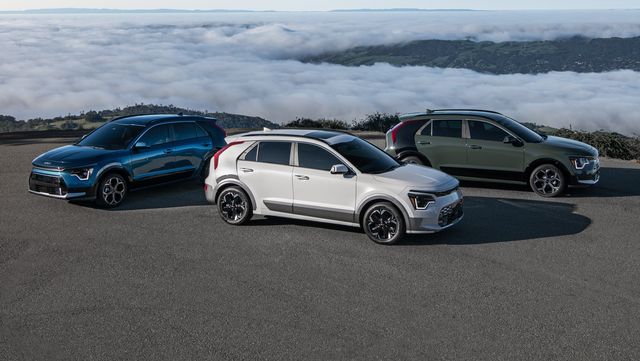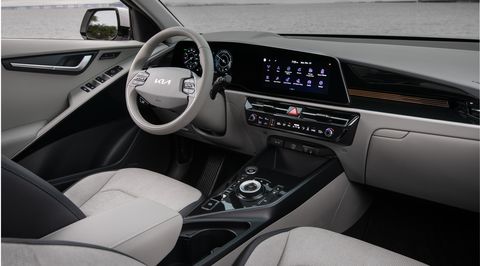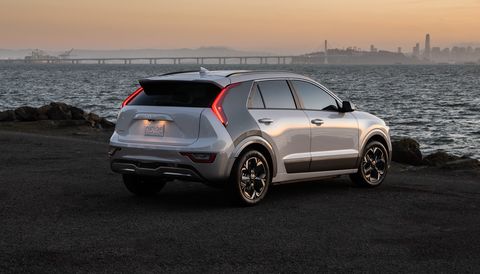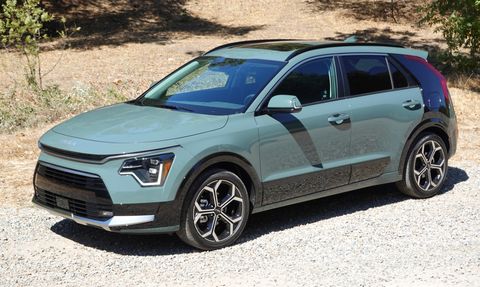- The budget-priced ($27,785) 2023 Kia Niro hybrid still produces 139 hp from its 1.6-liter four-cylinder engine paired to a six-speed DCT and 1.6-kWh battery pack.
- The Niro Plug-in Hybrid ($35,035) is much more potent than before, offering 180 total system horsepower (up 41 hp) and able to travel 33 all-electric miles, up 7 miles over the last one.
- The Niro EV (pricing not yet available) has an even 200 hp and gains 14 miles of range from its 64.8-kWh pack for an EPA estimated range of 253 miles.
When it comes to electrification, Kia has its bases covered with the EV6, the soon-to-drop 576-hp GT model, and next year’s seven-passenger EV9. The 2023 Niro might be all-new, but the company has maintained the old model’s distinctive three-powertrain model lineup—hybrid, plug-in hybrid, and electric.
EV evangelicals might wonder, aren’t we supposed to be moving toward a purely electrified future? But for the low-priced Niro, this three-pronged strategy ensures there’s a level of electrification for every need and every wallet. Considering the industry is still very much in the transition, that seems like a fair bet.
Although the powertrains for the new Niro are similar to the outgoing model, they’ve all been upgraded. The budget-priced ($27,785) hybrid offers the fewest changes. It still produces 139 hp from its 1.6-liter four-cylinder engine paired to a six-speed DCT and 1.6-kWh battery pack. But thanks to powertrain and aerodynamic improvements, the hybrid can now hit a solid 53 mpg combined and travel 588 miles on a tank of fuel.
The Plug-in Hybrid ($35,035) is much more potent than before, offering 180 total system horsepower (up 41 hp) from the 1.6-liter four cylinder, six-speed DCT, 88-hp electric motor, and 11.1-kWh battery pack. The new PHEV can travel 33 all-electric miles, up 7 miles over the previous one.
Finally, the Niro EV (pricing not yet available) has an even 200 hp and gains 14 miles of range from its 64.8-kWh pack for an EPA estimated range of 253 miles. And the Niro EV can charge that pack from 10% to 80% in under 45 minutes using DC Level 3 fast charging at a maximum of 85 kW. That’s not quite as quick as some newer EVs, like Kia’s own EV6, but still respectable for an EV in this price class.
No matter the model, the drive experience is vastly improved over the old version. The Niro rides on Kia and Hyundai’s new K3 platform, shared with the Hyundai Elantra. These are, indeed, very good bones. Dimensionally, the Niro grows slightly, with overall length up by 2.5 inches and a wheelbase stretched by almost an inch. It’s slightly wider too but no taller than before. And all that gives the Niro a more substantial and planted stance.
The old Niro’s cute-but-frumpy design is history. This new one is handsome, edgy, and downright cool. Yes, that contrasting color Aero Blade bisecting the C-pillar is a bit polarizing, but I think the look works here. It reminds me of the Audi R8, plus it’s functional. The blade actually funnels air beneath the taillamp to improve airflow. And the Niro is slippery, achieving a drag coefficient of 0.29.
And there’s a ton of standard equipment including dual-zone climate control, wireless Apple CarPlay, and Android Auto as well as a massive suite of safety equipment including forward collision avoidance, lane-keeping assist, and rear cross-traffic collision avoidance. There are dual USB ports on the seatbacks, for passengers in the back.
Our test hybrid model came with heated and ventilated seats as well as the Touring package, which blacks out the trim and includes 18-inch wheels and tires, aluminum pedals, a sunroof, full LED headlamps, and power folding mirrors. Those larger tires dial back the fuel-economy rating to 49 mpg.
On the road, the Niro Hybrid has a level of refinement and driving elan that surpasses the old model. And tackling the sweeping roads east of Encinitas, California, the hybrid feels planted and eager to hustle. It’s quiet and comfortable, too. Despite no increase in power, the hybrid does feel slightly torquier. Kia’s product planners say that comes from real-world powertrain tuning on American roads.
Still, when you stab the throttle on a freeway on-ramp, the Niro is predictably pokey. The Niro Hybrid’s Eco and Sport drive modes change throttle response but not much else. I found myself satisfied with Eco mode for most driving. The hybrid and PHEV models have a Green Zone drive mode that optimizes the use of an all-electric mode based on specific areas, like schools and residential neighborhoods. Smart.
Inside, the Niro looks fresh and modern. It borrows heavily from the EV6 and other new Kias. There’s the familiar 10.25-inch infotainment screen (EX and up) and a digital instrument cluster. The only old-school leftover inside is the hybrid’s traditional transmission shifter, which looks odd against a backdrop of large screens and capacitive touch buttons.
Kia uses quite a number of environmentally friendly materials in the cabin, including the somewhat coarse-feeling headliner made from recycled wallpaper. Our SX Touring (the top model) was equipped with much smoother and softer vegan leather seats.
The Niro is roomy for a CUV of this size. Our near-six-foot frame was able to sit behind our front seat position with plenty of knee room and a surprising amount of head clearance, too. Still, the Niro still isn’t particularly wide, so unless that middle passenger is kid-size, this is a four-seat car. The cargo hold fits 22.8 cu-ft of stuff with the rear seat in place. Fold it down and you’ll have a total of 63.7 cu-ft.
Later in the day we traded our hybrid for the battery-electric model. You’ll notice the EV by the distinctive front-end treatment as well as the centrally mounted charging port. Thanks to the big electric motor driving the front wheels (all Niros are front-wheel drive), acceleration is brisk compared to the hybrid. The Niro EV is good for a 0-60 mph time of about 7.8 seconds. For an EV, that’s not particularly quick, but it should be enough thrust for most buyers.
The EV is about 700 pounds heavier than the hybrid. It handles well but that extra heft makes the Niro feel less athletic on a tight road. Kia’s most aggressive i-Pedal regenerative brake setting (accessed by the steering wheel paddles) means you can forget about using the brake pedal most of the time. On the inside, the EV gains a large glossy black rotary shifter, similar to the one in the EV6. And it’s a far better match for the Niro’s interior.
The Niro EV also features bi-directional charging, which means it can export power from its battery pack just like the EV6. So if you find yourself needing to power a campsite’s worth of electronics, a Sub Zero refrigerator, or the A/V system in your home, the Niro EV can handle it—for a while.
Kia made a limited number of plug-in hybrid Niros available for shorter drives at the end of the day. You’ll spot one of these by the charging port located on the driver’s side fender. The PHEV strikes us as the Niro that’s the best compromise from a powertrain perspective. It’s noticeably quicker than the regular hybrid but isn’t saddled with all the extra weight of the battery-electric model.
And for those needing a vehicle to handle road trips without the hassle of a time-consuming recharge, the PHEV will go 510 miles on a tank. The PHEV is the Niro I’d park in my own driveway.
Is the Kia Niro on your shopping list, either as a hybrid, PHEV, or EV? Should Kia offer a model with internal-combustion only? Please comment below.



















